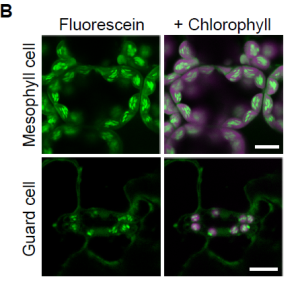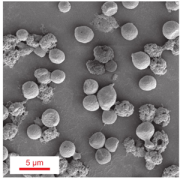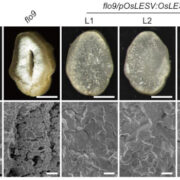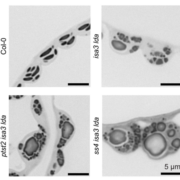Staining starch granules in living plants
 Starch granules are synthesized in the leaves of chloroplast during the day and degraded in the subsequent night. To visualise starch granules the tissue usually has to be fixed, which prevents live imaging. Here Ichikawa et al. set out to find a highly specific dye to image starch granules in living tissues. They tested a range of fluorescent dyes on Arabidopsis thaliana leaves and found that fluorescein stained granular structures in the mesophyll, guard cells and root tip. To test whether these were starch granules, they treated plants expressing the genetically encoded starch granule marker GBSSI-tagRFP (GRANULE BOUND STARCH SYNTHASE-RED FLUORESCENT PROTEIN) with fluorescein. The fluorescein signal overlapped with the RFP signal, confirming that fluorescein stains starch granules. The authors tested whether fluorescein could be used in other species and found it successfully stained starch granules in the bryophyte Marchantia polymorpha, and other flowering plants including strawberry, tomato and lettuce. Hence fluorescein provides an easy way to image starch granules in different species. (Summary by Rose McNelly @Rose_McN) Plant Physiol.10.1093/plphys/kiad528
Starch granules are synthesized in the leaves of chloroplast during the day and degraded in the subsequent night. To visualise starch granules the tissue usually has to be fixed, which prevents live imaging. Here Ichikawa et al. set out to find a highly specific dye to image starch granules in living tissues. They tested a range of fluorescent dyes on Arabidopsis thaliana leaves and found that fluorescein stained granular structures in the mesophyll, guard cells and root tip. To test whether these were starch granules, they treated plants expressing the genetically encoded starch granule marker GBSSI-tagRFP (GRANULE BOUND STARCH SYNTHASE-RED FLUORESCENT PROTEIN) with fluorescein. The fluorescein signal overlapped with the RFP signal, confirming that fluorescein stains starch granules. The authors tested whether fluorescein could be used in other species and found it successfully stained starch granules in the bryophyte Marchantia polymorpha, and other flowering plants including strawberry, tomato and lettuce. Hence fluorescein provides an easy way to image starch granules in different species. (Summary by Rose McNelly @Rose_McN) Plant Physiol.10.1093/plphys/kiad528








